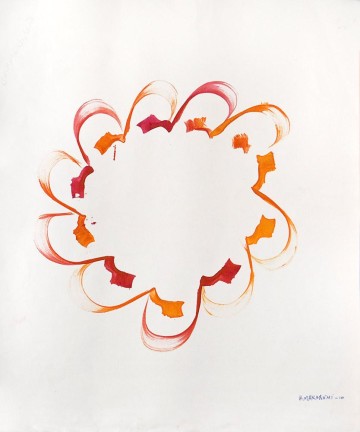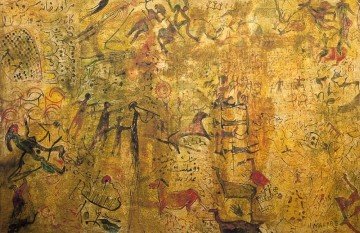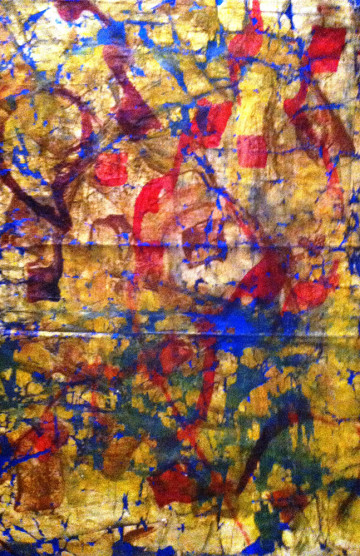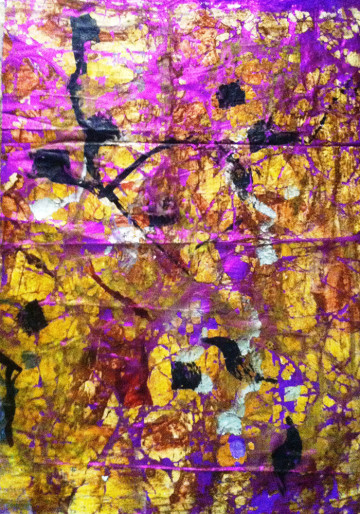马卡列米•汉森
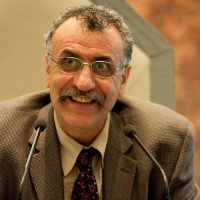
马卡列米•汉森
法国 巴黎
书法家、画家、心理分析师
The Calligraphy in my eyes
This poem, that I composed can explain well what calligraphy is for me:
“Abreast of the eyes of the sky, silence is blue,
Time slips away to the very end of our weariness”
If I often use a tree as a metaphor, it is because humanity has common roots, which give it a unity, thousands of branches that provide its diversity (its people, who are both so different and yet so intermixed) and countless leaves, the undulating products of its creative genius. Without its roots, firmly anchored in the ground, without its branches – even if some die while others flourish – without its leaves, continually “started afresh”, the tree could not survive.
In the West, since the 16th century, the choice has been made to opt for rapidity and efficacy, notably by trying to gain mastery over nature. In the East, the preference has been to “tell it” to “write it”, in its fullness and looseness, in its curves and silences, by leaving the space for interpretation, for freedom …
Far from my training as a scientist, there is this idea of renouncing rigour, clarity and concision. But I know that the computer keyboard will never replace the hand. And I reckon that, today, calligraphy represents added value. In a motion that is in harmony with nature, like a whirling Dervish, the gesture of the calligrapher-philosopher-poet turns the words of the Universe into song. That is nas’taliq calligraphy (Persian calligraphy): the alchemy of life!
On my research of the traces of the time in Persian calligraphy, what may I say? Over centuries, with patience and passion, the Masters of Persian calligraphy tried to put in harmony this calligraphy with the totality of Persian culture. To let myself go to the influence of the characters, while releasing myself from time; to swim in these signs, to be touched by the rain of the words; to leave time to take concerned sentences and worms, here is my passion which is devoted to your eyes. Where are these characters slipping from the hands of Masters thousands of years ago on handwritten books? Where are these words burned by the Mongols? Where are these poems lost in the deserts, melted in the imaginary one and nostalgias of people? Where are these curves to which people see the mirror of the universe? I seek them…
And on my course, I could say: “More than three billion years ran out between this initial bacterium and the advent of the human being homo sapiens, and then forty thousand other years were passed since this advent until our days. Life continues and, plus the years accumulate, resistance in front of death, “this thing”, which we call by simplification “life”, increases. As if the goals of any life were “life” against “death”. Beyond the fossils of our ancestors and historical and architectural witnesses who remain our witnesses of this course, there with rupestral art, there are writings, it is there with the oral culture, human cultural heritages. To continue to leave this heritage to our children, it remains with each one to trace this collective course of life; but each one on its own support”
The Calligraphy in my eyes can be seen through others' eyes also:
Some phrases from the UNESCO presentation:
“Influenced strongly by psychoanalysis, Iranian artist Hassan Makaremi has presented a different perspective on Persian culture for more than twenty years through a process linking its fundamental pillars: poetry, architecture, and calligraphy. Over fifteen centuries, the Persians brought two major modifications to their writings: the thickness of the strokes evolved and angles became more fluid. Through this latter, a playful harmony of curves took the place of straight angular strokes. Makaremi’s unique form of ”calligraphy-painting” helps bring appreciation to the beauty and finesse of this style of writing. “I seek to illustrate the coherence and the harmony between the images of architecture and painting, the influence of the curving images in drawing on calligraphy, the curvature of the domes of buildings in the letters of the written alphabet… to let oneself be taken by the influence of the letters, in freeing oneself from time, swimming in these symbols, being touched by the rain of words: this is my passion.”
Another critic in the UNESCO catalogue explains my works, by another point of view:
“An artist skilled in colouring his ideals:
The works of Hassan Makaremi carry us in an imaginary world where his humanistic ideas and his attention to life are described with a mixture of colours. His architectural compositions lead us to a world in which the magic of the moment is extended. Like the dance of mermaids, his calligraphies symbolize the harmony between the flexibility of the hand gliding over centuries of history and the mysterious maze of Persian poetry. His colourful paintings open one’s eyes at one time on an impressionist world, at another time on the delicacy of Persian miniatures. With the influence of psychoanalysis, his painting has presented a different perspective on the Persian cultural movement which spread over 700 years before our era. As Islam prohibits any representation of the human body, it is around architecture, poetry and calligraphy that the arts and literature show themselves. Hassan Makaremi thus expresses his thoughts on these three pillars: “I seek to illustrate the coherence and the harmony between the images of architecture and painting, the influence of the curving images and drawing on calligraphy, the curvature of the domes of buildings in the letters of the written alphabet…”.
He has this confidence to make on his search of the footprints of time in Persian calligraphy: “To let oneself be taken up by the influence of the letters, freeing oneself from time, swimming in these symbols, being touched by the rain of words: this is my passion which I submit to your eyes. Where are these letters which flew from the hands of masters a thousand years ago in the manuscripts, then melted in the imaginary and nostalgia of a people? Where are these curves thanks to which a people sees the mirror of the universe? I am looking for them.”
And finally the temoinage of General Director of UNESCO:
“Celebration of World Day of Cultural Diversity, 21st May
21st May 2009 – Cultural diversity offers a wealth of opportunities for mutual exchanges and borrowings, the head of the United Nations Educational, Scientific and Cultural Organization (UNESCO) said today, calling for nations to boost efforts to foster dialogue among cultures.
In a statement marking the World Day for Cultural Diversity for Dialogue and Development, Director-General Koïchiro Matsuura underscored his agency’s belief that cultures are interdependent, not monolithic, and that diversity is a source of strength and unity.
”Yet we see daily evidence of the destabilizing forces of ignorance and mistrust and of the magnitude of the task ahead of us,” he said. “The management of cultural diversity is undoubtedly one of the central challenges facing many societies today as they work to build inclusive and pluralistic knowledge societies.”
Two renowned calligraphers from different traditions – China and Iran – intertwined their writing to celebrate the Day at UNESCO headquarters in Paris. Master Fan Zeng and Hassan Makaremi provided a poetic illustration on learning how to learn about others and live together“.
